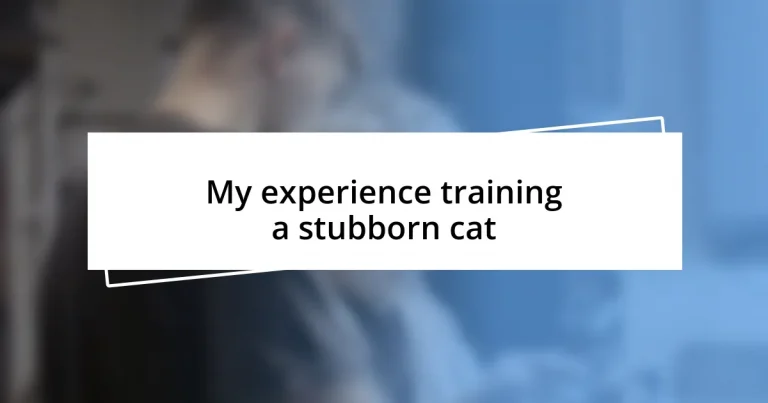Key takeaways:
- Understanding cat behavior involves observing body language and emotional responses, enhancing the bond between pet and owner.
- Utilizing the right training tools, such as clickers and high-value treats, can significantly improve training success.
- Establishing a consistent routine and celebrating small milestones helps build trust and motivation during training sessions.
- Adopting a patient and flexible approach allows for better engagement and learning, even during setbacks in training.

Understanding cat behavior
Understanding cat behavior can be quite a journey, one often filled with both laughs and frustrations. For instance, I once spent an entire afternoon trying to figure out why my cat, Luna, seemed to ignore my attempts to play with her. As it turned out, she simply preferred to watch from the windowsill, showcasing her natural instinct to observe before acting.
Cats are fascinating in how they express themselves. I remember the time when I thought my stubborn cat was just being aloof, but I later realized she was actually trying to communicate her discomfort. Have you ever noticed how your cat responds to your mood? It’s like they have a sixth sense, adjusting their behavior based on our emotions.
Things like tail position, ear orientation, and body posture are all clues to a cat’s feelings. I’ve often spent time watching my cats and reflecting on their body language; it’s like deciphering a secret code. When my feline companion would crouch low with ears back, I knew stress was in the air, prompting me to create a calm environment for her. Understanding these nuances can truly enhance the bond with your stubborn friend.

Choosing the right training tools
When I embarked on training my cat, I quickly discovered that the choice of tools could make or break the entire process. Initially, I tried using a spray bottle, but it only seemed to frustrate her more. The real turning point came when I found the perfect mix of positive reinforcement tools, like treats and clickers. It felt rewarding to see my cat actually respond to the sound of the clicker and then earn her favorite treat.
Here’s a list of training tools that I found helpful in my journey:
- Clicker: Creates a clear connection between behavior and reward, enhancing communication.
- High-value treats: Use soft, smelly treats that your cat loves; they work wonders!
- Harness and leash: Great for outdoor training sessions, allowing exploration without the risk of escape.
- Puzzle toys: Stimulate mental engagement, keeping your cat focused during training.
- Feather wands: Perfect for building play and rewarding good behavior in a fun manner.
I learned that having the right tools is essential, but using them creatively was key. For instance, pairing the clicker with a feather wand helped Luna engage in the training while having fun. It transformed our sessions from a chore into a game, making it easier for her to learn and for me to enjoy the process.

Techniques for stubborn cats
Training a stubborn cat can indeed be a test of patience and creativity. One technique that worked wonders for me was the “three-step method”: lure, reward, and repeat. Whenever I’d want Luna to come to me, I’d dangle her favorite toy just out of reach. The moment she moved towards it, I’d give her a treat. This not only motivated her but also built a sense of trust between us, which I found crucial in overcoming her stubbornness.
Another effective approach was to establish a consistent routine. For instance, I noticed that Luna responded better to commands when we trained at the same time each day. It became our little ritual, and she seemed to look forward to it! It’s fascinating how consistency can alter a pet’s behavior. Over time, I realized that my energy during training sessions significantly impacted her engagement. If I was upbeat and enthusiastic, she mirrored that energy, which led to more productive training moments.
Lastly, I embraced the concept of patience over perfection. Cats don’t always learn quickly, and I had to remind myself that setbacks were simply a part of the journey. One afternoon, after a particularly challenging session, I felt disheartened until I caught Luna playing with a puzzle toy I introduced during our training. It was like she was telling me, “Hey, I’m still learning!” This discovery reinforced my belief that celebrating small victories is just as important as tackling the bigger goals.
| Technique | Description |
|---|---|
| Three-step method | Lure your cat with a toy, reward on movement, and repeat for success. |
| Consistent routine | Train at the same time daily to build anticipation and signals for learning. |
| Patience over perfection | Acknowledge setbacks and celebrate small improvements in behavior. |

Positive reinforcement methods
Reward-based training has become my go-to method for connecting with my stubborn cat. Using high-value treats created a bridge between my expectations and her behavior. I remember one day, after several trials, I clicked the clicker just as she sat on command. Her ears perked up, and that moment of realization—the connection of action and reward—lit up her face. It’s in moments like these that I truly understood the power of positive reinforcement.
Incorporating play into training also enhanced our bond. During a particularly frustrating session, I discovered by accident that waving her favorite feather wand while offering treats kept her engaged. It’s incredible how the distraction of play can shift a cat’s mindset. I often wonder, how can something so simple make such a difference? I believe it’s the joy and enthusiasm I felt that resonated with her, transforming our training into quality time rather than just another task on my to-do list.
What I’ve learned is that patience is just as vital as the treats themselves. There were days when it felt like nothing clicked, and I felt tempted to give in. I had to remind myself that every little progress counts. I still cherish the memory of her finally responding to a command after weeks of repetition. It was a heartfelt moment, and I rejoiced as if we had achieved a major milestone together. I find it so rewarding to celebrate these tiny victories; they not only confirm her learning but also strengthen our relationship.

Dealing with setbacks in training
When setbacks occur in training, it’s easy to feel discouraged. I remember one particularly tough week when Luna simply refused to respond to any commands. After a few failed sessions, I took a step back and questioned if I was pushing too hard. It dawned on me that maybe I needed to adjust my approach rather than expecting her to meet my timeline. By changing things up—like introducing a new toy or trying a fresh treat—I found a way to reignite her interest and my own motivation.
Sometimes, I felt like I was making no progress, and it was frustrating! There were days when I thought, “Is this even working?” Yet, I realized that every cat has its own learning pace. One afternoon, after a disappointing session, I caught Luna happily batting around the treats I had scattered. That moment reminded me that she was still engaging with our training in her own way. It was a lightbulb moment; sometimes setbacks are just opportunities to find new angles and methods that resonate better with our pets.
Reflecting on those frustrating times, I learned the value of self-compassion. I had to forgive myself for the tougher days and remember that training an animal isn’t just about the end goals. Each setback felt like a reminder to enjoy the journey with Luna. After all, who wouldn’t love a playful distraction during a tough session? Sometimes, acknowledging my own frustrations led to a more relaxed approach, allowing both of us to embrace the process together.

Building a routine for success
Creating a consistent routine for training my cat was an eye-opening experience. I quickly discovered that cats thrive on predictability, much like we do. Each morning, I dedicated the first 10 minutes to our training session, combining it with her meal times. I vividly remember the day she responded perfectly right after breakfast—her little triumph felt like our shared victory.
Establishing a routine not only set clear expectations but also helped reduce her anxiety. Whenever Luna knew what to expect, her stubbornness seemed to ease up a bit. There were moments when I could sense her inner struggle; it was almost as if she thought, “Do I really have to do this?” Recognizing that made me more patient, leading me to reward her more generously during those crucial early sessions.
Looking back, I realize that my commitment to a routine transformed our training into a bonding experience. It built trust between us. Sometimes, I would sit on the floor and simply talk to her, creating a relaxed atmosphere before we began—almost like a warm-up chat before an important game! This simple act fostered a deeper connection and made our training sessions something she looked forward to, rather than a chore. Isn’t it fascinating how a structured approach can change the game entirely? I believe that’s the essence of building a successful training routine!

Celebrating training milestones
Celebrating milestones in training my stubborn cat was a rewarding experience that filled me with joy. I remember the first time Luna responded to a command—I was over the moon! I jumped up and cheered, and then I offered her a delicious treat. It wasn’t just my excitement; I could see her little ears perk up, almost as if she was basking in the praise. Have you ever had those moments where it felt like all your efforts paid off in a heartbeat? Those are the ones that keep you motivated.
There were quieter milestones, too, like the first time she approached me voluntarily during training. It was a subtle victory, but it made my heart swell. She seemed to choose to engage rather than feeling pressured. I took a moment to relish that victory, celebrating in my mind how far we’d come. Recognizing these small successes helped me build a positive reinforcement cycle. Did you know that acknowledging progress, no matter how small, can significantly boost a pet’s confidence? It’s true!
Eventually, I started incorporating mini celebrations into our training routine. A little dance or a joyful shout whenever she achieved a new skill had a fantastic effect. I found that these moments not only made me feel good but also created a playful atmosphere during our sessions. Imagine turning a learning moment into a fun game; that’s the kind of bond you cultivate. Have you thought about how small celebrations could enhance your training experience with your own pet? It seems to me that sometimes a little joy can exponentially increase your success!














